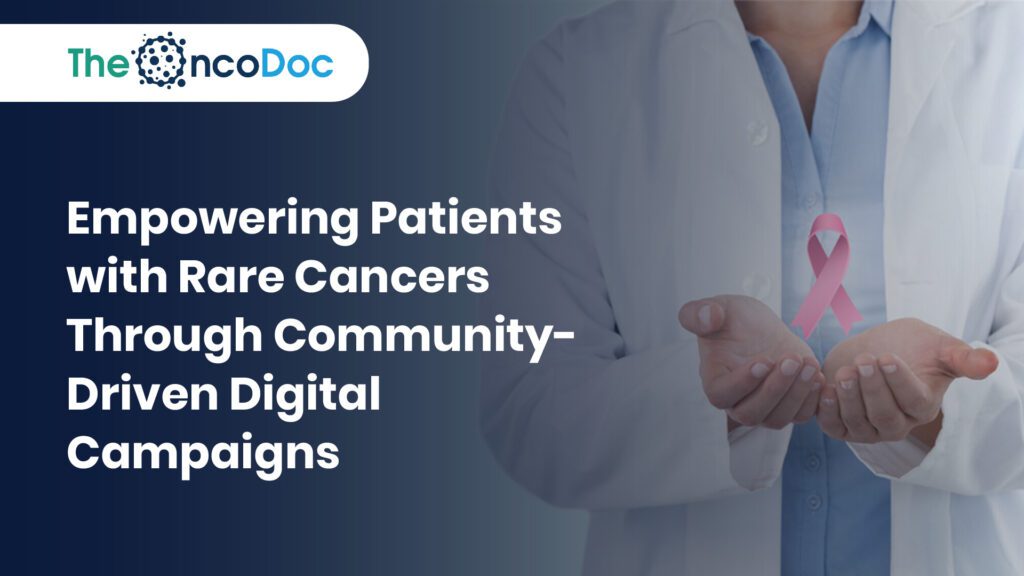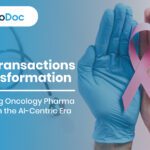Abstract
Rare cancers, by their very definition, affect a small percentage of the population, leading to unique challenges in diagnosis, treatment, and support. Patients often face protracted diagnostic odysseys, limited access to specialized expertise, and profound feelings of isolation. This article explores the transformative potential of community-driven digital campaigns in empowering patients with rare cancers. It argues that leveraging digital platforms to foster peer-to-peer connections, disseminate accurate information, and amplify patient voices is not merely a supportive measure but a strategic imperative for pharmaceutical companies, healthcare providers, and advocacy groups. We will delve into effective digital marketing analytics to measure the impact of these campaigns, discuss best practices for building authentic online communities, and address the critical ethical considerations in fostering empowerment and improving outcomes for this underserved patient population.
Introduction
The term “rare cancer” evokes a myriad of challenges: a paucity of research, often delayed or misdiagnoses, and a limited pool of specialists. Defined in Europe as cancers with an incidence of fewer than 6 cases per 100,000 people per year, these diseases collectively represent a significant portion of the oncology landscape. For individuals living with rare cancers, the journey can be profoundly isolating, marked by a constant search for reliable information, empathetic support, and access to cutting-edge therapies. Unlike more common cancers, where robust patient communities and extensive resources often exist, rare cancer patients frequently feel overlooked and unheard.
In this context, digital technologies have emerged as a powerful equalizer. The internet, social media, and specialized online platforms offer unprecedented opportunities to connect geographically dispersed patients, build vibrant communities, and disseminate vital information at scale. For pharmaceutical companies, healthcare providers, and patient advocacy organizations, the strategic application of community-driven digital campaigns is no longer optional; it is essential for driving awareness, facilitating diagnosis, supporting adherence, and ultimately, empowering patients with rare cancers to navigate their complex journeys with greater confidence and connection. This article will dissect the unique landscape of rare cancers, explore the profound impact of digital communities, outline actionable strategies for implementing and measuring these campaigns, and emphasize the critical ethical responsibilities inherent in this deeply patient-centric approach.
The Unique Landscape of Rare Cancers: Challenges and the Digital Imperative
Patients with rare cancers face a distinct set of hurdles that necessitate a specialized approach to engagement and support:
- Diagnostic Odyssey: The rarity of these conditions often means healthcare professionals have limited exposure, leading to diagnostic delays, misdiagnoses, and prolonged periods of uncertainty for patients. Patients frequently become “experts” in their own condition out of necessity, actively seeking information online.
- Limited Information and Expertise: Research on rare cancers is often scarce, resulting in a lack of comprehensive guidelines for treatment. Specialized centers and expert clinicians are few and far between, making access to informed care a significant challenge, particularly for those in remote areas.
- Small, Dispersed Patient Populations: The inherently small patient numbers make traditional patient aggregation difficult. Patients and caregivers are geographically scattered, hindering the formation of in-person support networks.
- Psychosocial Burden and Isolation: The feeling of being “the only one” can lead to profound emotional distress and social isolation. Patients may struggle to find others who understand their specific challenges, fears, and triumphs.
- Access to Clinical Trials and Therapies: Recruiting for clinical trials in rare cancers is notoriously difficult due to small patient pools. Furthermore, the development of orphan drugs (medicines for rare diseases) faces unique economic considerations due to smaller market sizes.
Given these formidable challenges, digital platforms are uniquely positioned to bridge gaps, build connections, and address unmet needs. They enable patients to find information, connect with peers globally, access virtual consultations, and become advocates for their own conditions.
The Power of Community: Building Bridges in the Digital Realm
Online communities serve as lifelines for rare cancer patients and their caregivers, offering multi-faceted support:
- Emotional Support and Validation: Connecting with others who share similar diagnoses and experiences provides immense emotional validation, reducing feelings of isolation and fostering a sense of belonging. Sharing personal stories and receiving empathetic responses can be profoundly therapeutic.
- Information Exchange and Knowledge Sharing: These communities become vibrant hubs for sharing practical advice on symptom management, navigating healthcare systems, understanding treatment side effects, and even identifying specialized clinicians or clinical trials that might not be widely publicized.
- Collective Advocacy and Amplified Voice: When individual patients unite, their collective voice gains power. Online communities can mobilize for advocacy, fundraising, and influencing policy, bringing much-needed attention and resources to their specific rare cancer. Patient advocacy groups (PAGs) often form the backbone of these online movements, acting as trusted intermediaries between patients, researchers, and pharmaceutical companies.
- Navigating Misinformation (and its risks): While online communities offer valuable information, they also carry the risk of spreading misinformation or unverified “cures.” Reputable community-driven campaigns, particularly those partnered with medical professionals or PAGs, focus on curating and disseminating evidence-based information.
Designing Community-Driven Digital Campaigns: Strategic Imperatives
For pharma companies and healthcare providers, engaging authentically with rare cancer communities requires a nuanced, empathetic, and analytics-informed strategy:
1. Partnership with Patient Advocacy Groups (PAGs): * Co-creation is Key: PAGs are often the most trusted voice in a rare cancer community. Pharma should prioritize genuine partnerships, not just sponsorships. This means co-developing educational content, campaign messaging, and support programs to ensure they are truly patient-centric and meet real needs. * Amplify, Don’t Control: Leverage PAGs’ existing digital platforms and networks to amplify messages, rather than creating parallel, pharma-branded channels that might be perceived as less authentic. * Listen Actively: PAGs serve as invaluable listening posts. Engage with them to understand unmet needs, information gaps, and the lived experiences of patients. This feedback should directly inform campaign development and even R&D priorities.
2. Content Strategy: Education, Empathy, Empowerment: * Accessible Information: Create clear, concise, and easy-to-understand content about the rare cancer, its diagnosis, and treatment options. Utilize diverse formats: explainer videos, infographics, patient journey maps, and FAQs. Avoid medical jargon. * Personalized Resources: Leverage data (with strict privacy protocols) to tailor content to specific patient sub-groups or stages of their journey. For example, a newly diagnosed patient might need foundational information, while a patient undergoing treatment might seek resources on managing specific side effects. * Patient Stories (Ethical & Authentic): Curate and share authentic patient and caregiver stories (with explicit consent) that highlight resilience, challenges, and hope. These resonate deeply and foster connection. Video testimonials can be particularly impactful. * Expert Q&As and Webinars: Host live or recorded sessions with leading rare cancer specialists, allowing community members to ask questions directly. Promote these widely within the target digital communities.
3. Platform Selection and Community Building: * Meet Patients Where They Are: Identify the digital spaces where rare cancer patients already congregate (e.g., specialized forums, private Facebook groups, rare disease apps like RxPx, or condition-specific online communities). Engage respectfully within these existing ecosystems. * Facilitate Peer-to-Peer Support: Create or support platforms that enable secure peer-to-peer connections. This could involve moderated forums, chat groups, or virtual meet-ups. Ensure moderation is in place to prevent misinformation and foster a safe environment. * Hybrid Models: Consider combining digital community efforts with infrequent, high-impact in-person events (e.g., patient summits, advocacy days) to strengthen online bonds.
4. Search Engine Optimization (SEO) for “Uncommon” Searches: * Long-Tail Keywords: Optimize websites and content for highly specific, long-tail keywords related to rare cancer symptoms, diagnostic names, and treatment options that patients are likely to search for when experiencing unusual symptoms or after receiving a rare diagnosis. * Question-Based Content: Develop content that directly answers common questions posed by rare cancer patients and caregivers (e.g., “What are the first signs of X rare cancer?”, “Where can I find a specialist for Y cancer?”). * Leverage Medical SEO: Ensure content is medically accurate, uses authoritative sources, and follows E-E-A-T (Experience, Expertise, Authoritativeness, Trustworthiness) principles to rank highly in search results.
5. Ethical Digital Advertising and Outreach: * Targeted, Not Intrusive: Use digital advertising platforms (e.g., programmatic display, social media ads) to reach highly specific demographics and psychographics (e.g., patients recently searching for related terms, or HCPs in relevant specialties). Ensure ads are informational and empathetic, not overtly promotional. * Geo-Targeting: For local support groups or specialized clinics, use geo-targeting to reach patients in relevant geographical areas. * Retargeting with Care: While retargeting can be effective, use it with extreme sensitivity in oncology. Focus on providing helpful resources to those who have previously engaged with educational content, rather than pushing sales messages.
Analytics for Community-Driven Campaigns: Measuring Empowerment and Impact
Measuring the success of community-driven campaigns in rare cancers goes beyond traditional ROI. It requires a nuanced understanding of engagement, sentiment, and the ultimate impact on patient well-being and clinical pathways.
- Community Engagement Metrics:
- Active Users/Members: Number of unique individuals regularly engaging with the community platform.
- Content Contribution: Posts, comments, replies, and shared resources within the community.
- Peer-to-Peer Interactions: Number of direct messages, forum replies, or social media interactions between community members.
- Time Spent on Platform: Indicates the depth of engagement and perceived value of the community.
- Sentiment Analysis: Monitoring discussions for positive, negative, or neutral sentiment to gauge emotional support and overall community health.
- Content Effectiveness Metrics:
- Downloads/Views of Educational Resources: Which fact sheets, videos, or guides are most accessed?
- Click-Through Rates (CTR) on Informational Links: How many users are clicking through to detailed medical information or clinical trial listings?
- Search Query Analysis: What questions are patients asking that can inform future content creation?
- Website Traffic and User Behavior: Track patient journeys on owned websites—where do they go, what do they read, and are they finding the information they need?
- Awareness and Diagnostic Acceleration Metrics:
- Brand Mentions/Advocacy: Track mentions of the disease, specific diagnostic tests, or therapies on social media and forums.
- Referral Tracking: If patients are directed to specialists or diagnostic centers, track the digital source of these referrals.
- Self-Reported Diagnosis Time (Survey-based): Conduct surveys within the community to assess if digital resources contributed to a quicker or more accurate diagnosis.
- Adherence and Quality of Life Metrics:
- Engagement with Support Programs: Track participation in digital adherence programs or patient support services.
- Patient-Reported Outcomes (PROs) (Anonymized & Consent-Based): If integrated ethically and with consent, digital platforms can collect anonymized PRO data to assess the impact of community support on patient well-being.
- Surveys on Perceived Empowerment: Measure changes in patient confidence, knowledge, and ability to self-advocate.
Analytics in Action: A Case Study
Consider a pharma company launching a new therapy for a rare neuro-oncological cancer.
- Challenge: Limited patient population, low awareness among general neurologists, and patient isolation.
- Community-Driven Digital Campaign:
- Phase 1 (Awareness): Partner with key rare neurological cancer PAGs to co-create an educational content series (videos, infographics) on early symptoms and diagnostic pathways, distributed across social media and PAG websites.
- Analytics: Track video completion rates, shares, and website traffic to the educational hub. Analyze search trends for symptom-related keywords.
- Phase 2 (Support & Connection): Support the creation of a moderated online forum for patients and caregivers, featuring regular Q&A sessions with a key opinion leader (KOL).
- Analytics: Monitor forum activity (posts, replies), unique active users, and sentiment analysis for discussions around emotional support and shared experiences. Track participation in KOL Q&As.
- Phase 3 (Treatment & Adherence): Offer an opt-in digital patient support program with personalized information on the new therapy and adherence reminders.
- Analytics: Track enrollment rates in the program, engagement with personalized content, and anonymized adherence data (if applicable and consented). Conduct pre/post surveys on patient confidence in managing their condition.
This iterative process, driven by both community feedback and granular analytics, ensures that campaigns remain relevant, impactful, and truly empowering.
Ethical Imperatives in Empowering Rare Cancer Communities
The sensitivity of rare cancer patients demands unwavering ethical commitment:
- Authenticity and Transparency: Pharma companies must approach communities with genuine intent to support, not merely to market. Disclose all partnerships and funding.
- Privacy and Data Security: Robust measures are critical to protect sensitive patient data. Ensure clear consent for data collection and usage, emphasizing anonymization and aggregation for analytical purposes.
- No Exploitation of Vulnerability: Avoid language or imagery that induces fear or promotes unrealistic expectations. Campaigns must focus on providing hope through accurate information and genuine support.
- Curation of Information: Actively combat misinformation by providing clear, evidence-based content and directing users to reputable medical sources.
- Empowerment, Not Manipulation: The goal is to empower patients to make informed decisions with their healthcare providers, not to steer them towards specific products without balanced information.
- Digital Health Literacy: Recognize that not all patients have equal digital literacy. Design content and platforms that are accessible and easy to navigate for all.
Future Outlook: AI, Personalization, and Integrated Ecosystems
The future of empowering rare cancer patients through digital campaigns will likely see:
- Advanced AI-driven Personalization: AI algorithms can analyze vast datasets to deliver hyper-personalized content and support, anticipating individual patient needs and preferences within the community context.
- Virtual Reality (VR) and Augmented Reality (AR): immersive technologies could provide empathetic support environments or interactive educational experiences for complex rare cancer information.
- Telemedicine Integration: Seamless integration of community platforms with telemedicine services, allowing patients to easily transition from online peer support to professional medical advice.
- Interoperable Data Ecosystems: Greater collaboration between PAGs, pharma, healthcare systems, and researchers to create integrated data platforms (with robust privacy safeguards) that accelerate research and improve patient care, leading to earlier diagnoses and more targeted treatments.
Conclusion
Empowering patients with rare cancers is not just a moral imperative; it is a strategic pathway to improve health outcomes and accelerate scientific progress. Community-driven digital campaigns, when designed with empathy, authenticity, and rigorous analytical oversight, offer a powerful means to address the unique challenges faced by this underserved population. By fostering connection, providing reliable information, and amplifying patient voices, pharmaceutical companies and healthcare providers can move beyond transactional marketing to build lasting trust and genuine partnerships. In an era where digital proximity can transcend geographical distance, harnessing the power of online communities is essential for illuminating the paths of those living with rare cancers, ensuring they are seen, heard, and supported every step of their journey.
The Oncodoc team is a group of passionate healthcare and marketing professionals dedicated to delivering accurate, engaging, and impactful content. With expertise across medical research, digital strategy, and clinical communication, the team focuses on empowering healthcare professionals and patients alike. Through evidence-based insights and innovative storytelling, Hidoc aims to bridge the gap between medicine and digital engagement, promoting wellness and informed decision-making.



